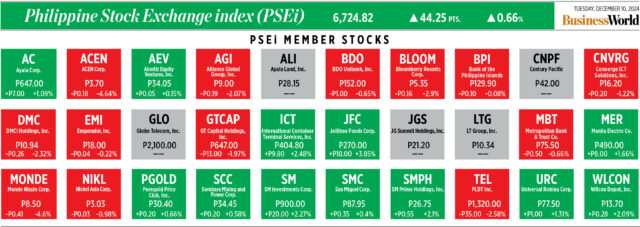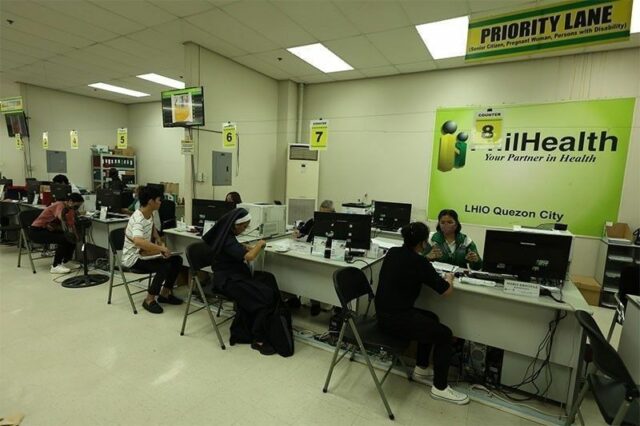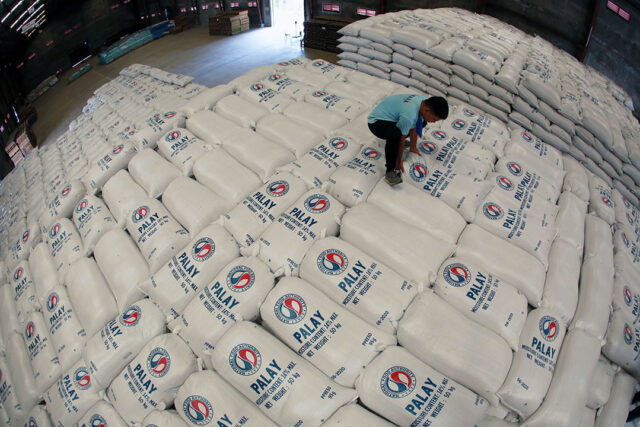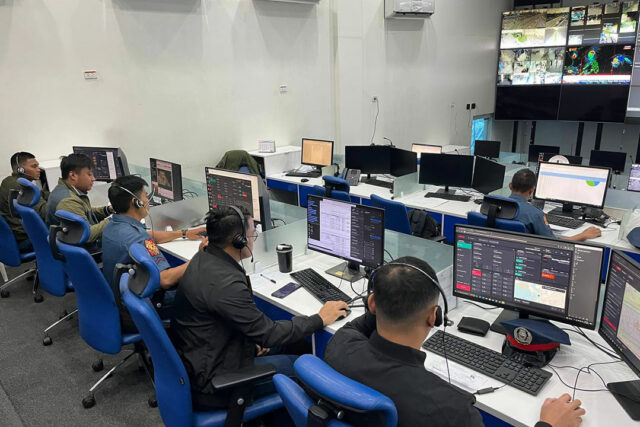Manila to continue resupply missions in S. China Sea, won’t escalate tension
PRESIDENT Ferdinand R. Marcos, Jr. on Tuesday said the Philippines would continue its resupply missions in the South China Sea without the need to deploy the navy, despite a recent incident with Chinese vessels.
“We are not at war, we don’t need navy warships,” he told reporters in Bulacan province. “All we are doing is resupplying our fishermen, protecting our territorial rights.”
At the weekend, Philippine Coast Guard spokesman Jay Tristan Tarriela told a forum that deploying a warship could be a “policy option” for the Marcos government to deter Chinese harassment of fishermen, and Beijing blocking resupply missions to a disputed shoal in the waterway.
“We will never be part of an escalation in the West Philippine Sea,” Mr. Marcos said, referring to areas of the waterway within the country’s exclusive economic zone (EEZ). “It will be provocative and will be seen as an escalation; we don’t do that.”
He added that the government would continue supporting Filipino fishermen.
On Dec. 4, Chinese Coast Guard vessels fired a water cannon and side-swiped a Manila Fishery bureau boat transporting supplies to Filipino fishermen operating near Scarborough Shoal, a prime fishing patch, according to Philippine officials.
Philippine Coast Guard vessels also faced “blocking, shadowing and dangerous maneuvers” from a Chinese navy vessel.
The Philippines will not deploy its own navy warships in the area to prevent provocation and escalation, Mr. Marcos said.
The Philippines filed a diplomatic protest against China, which claims almost all of the South China Sea. The Philippines under Mr. Marcos has filed 193 diplomatic protests over China’s actions in the South China Sea, 60 of which were filed this year, Foreign Affairs spokesperson Ma. Teresita C. Daza told reporters in a WhatsApp message last week.
The Chinese Embassy in Manila did not immediately respond to a request for comment. China’s coast guard last week said Philippine ships “dangerously approached” Beijing’s territorial waters around the Scarborough Shoal.
Meanwhile, Tokyo, Washington and Manila reaffirmed their opposition to “any unilateral attempts to change the status quo by force” in the South China Sea, the Japanese Embassy in Manila said in a statement, citing high-ranking diplomats, coast guard and military officials at a maritime dialogue in Tokyo.
The Philippines held maritime drills with the US and Japan within its exclusive economic zone in the South China Sea, its military said on Friday, two days after a maritime confrontation with Beijing around Scarborough Shoal.
The drills, which brought together a US Navy P-8A Poseidon aircraft, Philippine Navy ship BRP Andres Bonifacio and a small C-90 plane, and Japan’s Murasame-class destroyer JS Samidare, are the Philippines’ latest round of exercises with allies this year in the face of an increasingly assertive China.
The exercises were conducted “in a manner that is consistent with international law, and with due regard for the safety of navigation, and the rights and interests of other states,” the Armed Forces of the Philippines and US Indo-Pacific Command said in separate statements.
On Dec. 4, the Philippines accused Chinese Coast Guard vessels of firing water cannons and side-swiping one of its boats while expressing alarm over the presence at the shoal of a Chinese Navy vessel which it said blocked and shadowed its coast guard ships, in what it described as a “steep escalation and provocation.”
China, which claims almost all of the South China Sea, including Scarborough Shoal, maintains that its actions are lawful.
Brunei, Malaysia, Taiwan, The Philippines and Vietnam all claim parts of the sea. Tensions have risen amid concern China’s expansive claims encroach on their exclusive economic zones.
EEZs extend 200 nautical miles (370 kilometers) from a country’s coast and allow it sovereign rights to explore and exploit the natural resources in the water and on the ocean floor.
China has rejected a 2016 ruling by the Permanent Court of Arbitration in The Hague that its claims have no basis under international law.
Sovereignty over Scarborough Shoal has never been established, but the tribunal ruled that China’s blockade there violated international law and that the area is a traditional fishing ground used by fishermen of many nationalities. — John Victor D. Ordoñez with Reuters
Marcos gov’t to prioritize cybersecurity measure
By John Victor D. Ordoñez, Reporter
A BILL that seeks to boost Philippine cybersecurity has been added to the Marcos government’s list of priority measures, according to the Department of Information and Communications Technology (DICT), as Manila beefs up its defenses from hackers before midterm elections next year.
“We’ve consolidated it already and we’re just fine-tuning it,” DICT Secretary Ivan John E. Uy told BusinessWorld on the sidelines of a Foreign Affairs department event on Monday.
He said the measure was brought up during the seventh meeting of the Legislative-Executive Development Advisory Council (LEDAC) at the presidential palace on Monday.
“We’re encouraging foreign investments as well as local investments in data centers because we’re seeing a huge uptake already for storage and processing of data, especially with AI (artificial intelligence),” he added.
“The government should establish a unified national framework to prevent, detect, respond to and recover from cyberincidents,” Ronald B. Gustilo, national campaigner for Digital Pinoys, said in a Viber message. “The bill should also push the government to develop protocols for collaboration among government agencies, the private sector and international partners.”
DICT Undersecretary Jeffrey Ian C. Dy earlier told reporters the National Cybersecurity bill would include fines and administrative penalties against groups that operate critical information infrastructure that fail to report cyberattacks to the government.
In 2022, the Philippines only had about 200 cybersecurity professionals compared with 2,000 in Singapore, Mr. Uy earlier said, noting that 80% of Filipino cyberexperts work overseas.
The DICT chief has said the government is finding it hard to attract more cybersecurity experts due to lower pay at about P50,000 a month, compared with about P200,000 in the private sector.
The government has identified and addressed more than 20,144 vulnerabilities in state cybersecurity systems this year, DICT Undersecretary David L. Almirol, Jr. told a Senate hearing in October.
He also said his agency was considering proposing an executive order on protecting the government’s digital infrastructure from hackers and other cyberthreats.
The Philippine National Police’s Anti-Cybercrime Group earlier reported 4,469 cybercrime incidents in the country in the first quarter, up 21.84% from a year earlier.
Last year, the Philippine Health Insurance Corp. was hit by Medusa ransomware, with more than 600 gigabytes of data stolen by hackers.
The creation of a national cybersecurity agency, which could conduct regular audits of cybersecurity infrastructure, is crucial,” Dominic Vincent D. Ligot, founder of CirroLytix Research Services and a consultant for the Information Technology (IT) and Business Process Association of the Philippines, told BusinessWorld in an e-mail.
“These audits should ensure compliance with security standards without compromising individual rights and privacy,” he added.
WATER BODY
Meanwhile, on Monday’s LEDAC meeting, the National Economic Development Authority (NEDA) pushed a bill that will create a Department of Water Resources (DWR) amid constant flooding and to boost farm output.
“By integrating the country’s governance and regulation of water resources, the DWR will contribute to national efforts to achieve comprehensive water security,” NEDA said in a statement.
The priority measure also seeks to set up a Water Regulatory Commission, a quasi-judicial body that will oversee water service providers.
The House of Representatives approved its version of the bill in December last year, while the Senate has yet to continue plenary debates on a counterpart bill.
“The recurring devastation caused by heavy typhoons necessitates that we prepare for our country’s future and safety,” NEDA Secretary Arsenio M. Balisacan said in the statement.
The NEDA Board last month approved a 65-month extension in the implementation of the Cavite Industrial Area-Flood Risk Management project, which was meant to be operational from October 2019 to April 2024.
It also approved a 63-month extension in the implementation of the fourth phase of the Pasig-Marikina River Channel Improvement project, which would be operational from this month until March 2031.
Philippine President Ferdinand R. Marcos, Jr. has issued an executive order transferring the control of the National Irrigation Administration to his office, which is expected to pave the way for better irrigation projects.
NEDA said 29 of the 64 priority bills this year have been signed into law.
Public Works Secretary Manuel E. Bonoan earlier said the government had about 5,000 ongoing flood control projects this year. These are on top of the 5,521 flood control projects completed between July 2022 and May 2024, according Mr. Marcos.
Congress has been scrutinizing state flood-control projects after houses and people mostly in Metro Manila and nearby provinces were swept away by raging flood waters from tropical storms this year.
“The Department of Water Resources will be mandated to coordinate with relevant agencies on the construction of water projects that will improve our irrigation and flood management,” Mr. Balisacan said.
Marcos orders better traffic control during holidays
PRESIDENT Ferdinand R. Marcos, Jr. on Tuesday urged the Toll Regulatory Board (TRB) and NLEX Corp. to double their efforts to come up with traffic management strategies ahead of the expected influx of holiday travelers this month.
At the inauguration of the North Luzon Expressway (NLEX) Candaba Third Viaduct in Bulacan, he said the P7.8-billion bridge is expected to ease congestion and boost the transport of goods between Central Luzon and Metro Manila.
NLEX Corp., a unit of Metro Pacific Tollways Corp. (MPTC), started building the five-kilometer viaduct in June last year that connects the towns of Pulilan, Bulacan and Apalit, Pampanga.
“As we enter the holiday season, a period marked by heightened activity and an influx of holiday travelers, this bridge becomes even more crucial,” Mr. Marcos said at the inauguration, based on a statement from the Presidential Communications Office.
“Let us prioritize swift response mechanisms and deploy well-coordinated traffic management strategies to address the ever-changing conditions and the increasing demands on our toll roads.”
The President in April ordered agencies to come up with a comprehensive approach to fix Metro Manila’s traffic crisis.
Traffic congestion in Metro Manila costs the Philippine economy at least P3.5 billion daily, according to the Japan International Cooperation Agency.
Mr. Marcos said the viaduct would ease traffic congestion and expand opportunities for trade and tourism.
“Let me assure everyone that the Department of Transportation and Toll Regulatory Board are implementing measures to ease congestion and to ensure smoother travel across this corridor,” he added.
MPTC is the tollway unit of Metro Pacific Investments Corp., one of three key Philippine units of Hong Kong-based First Pacific Co. Ltd., the others being Philex Mining Corp. and PLDT, Inc.
Hastings Holdings, Inc., a unit of PLDT Beneficial Trust Fund subsidiary MediaQuest Holdings, Inc., has a majority stake in BusinessWorld through the Philippine Star Group, which it controls. — J.V.D. Ordoñez
Congress urged to restore PhilHealth budget
A GROUP has urged Congress to restore the funding it cut from the Philippine Health Insurance Corp.’s (PhilHealth) budget next year as lawmakers finalize this next year’s national spending plan, citing the need for the agency to cover the premiums of its contributors.
PhilHealth had requested a budget of P150.92 billion for 2025, covering the premiums of 25.28 million indirect contributors, the group, led by Senate Minority Leader Aquilino Martin L. Pimentel, said in a statement, dated Dec. 9.
The National Expenditure Program (NEP), however, slashed the agency’s budget to P53.13 billion, while the Senate approved General Appropriations Bill (GAB) for 2025 provided an even lower funding of P47 billion for indirect contributors.
“It harms the whole membership; not only does this degrade the membership of indirect contributors, but it also makes the direct contributors, majority of whom are from the working class, bear a much heavier burden of providing the financial risk protection of all,” the statement read.
It was signed by Mr. Pimentel, former Finance Undersecretary Secretary Cielo D. Magno, Sentro ng mga Nagkakaisa at Progresibong Manggagawa, Philippine Medical Association, and Public Services Labor Independent Confederation Foundation, Inc. among others.
The group consists of the same petitioners that asked the Supreme Court to declare the transfer of P90-billion PhilHealth funds to the national government unconstitutional.
They argued that defunding PhilHealth would worsen its financial crisis, citing the agency’s financial statement which revealed it does not have “excess” funds. This means it has limited sources to fund future liabilities, which include new benefits and programs such as the Konsulta program.
The group said it would file a case before the Supreme Court challenging the budget cut if lawmakers decide not to restore the funding since it is illegal.
Senators Joseph Victor G. Ejercito and Ana Theresia N. Hontiveros-Baraquel did not immediately reply to separate Viber messages seeking comment.
The Senate’s final version of the 2025 spending plan cut PhilHealth’s budget to P64.42 billion from P74.43 billion as proposed in the counterpart House bill, based on a copy sent to reporters on Wednesday.
Lawmakers are set to finalize and ratify the Bicameral Conference Committee Report of the 2025 P6.352-trillion national budget this week.
The Department of Health is allocated a budget of P285.51 billion next year, higher than the P217.38 billion under the NEP proposed by the Budget department.
By slashing budgetary support for premiums of indirect contributors, the government is neglecting its duty under the Universal Health Act to cover the premiums of poor Filipinos.
Under the Sin Tax Law, 80% of half of the total revenue from tobacco and sweetened shall be earmarked to PhilHealth to implement the Universal Healthcare (UHC) Act.
For 2025, the Sin Tax Law earmarks funds for PhilHealth worth P69.81 billion next year.
The group noted that the P53.13-billion and P47-billion proposed funding, under the NEP and the Senate’s GAB not only “fall way below the budget of P150.92 billion that PhilHealth requested, they also violate what PhilHealth should be getting from the Sin Tax Law earmarking.”
Moreover, the group flagged the insertion of a provision that would bypass health technology assessment, which it considered “unconstitutional.”
“We oppose any attempt to insert a Special Provision in the Medical Assistance to Indigent and Financially-Incapacitated Patients (MAIFIP) budget that will allow the purchase of medicines not approved by HTAC and not included in the Philippine National Drug Formulary,” the group said, noting it violates Section 34 of the UHC Act, which mandates the determination of entitlements to undergo the HTAC process.
“We believe that it is unconstitutional for Congress to use the appropriations law as a vehicle for changing the Sin Tax Laws and Universal Healthcare Act. Congress is inserting these riders, amending, and weakening laws that guarantee our health, and doing so through the backdoor.” — John Victor D. Ordoñez
P13.3-B foregone revenues seen
THE PHILIPPINE government’s decision to cut tariffs on rice amid low supply and soaring prices has resulted in P13.3 billion in foregone revenues to date, according to the Bureau of Customs’ (BoC) data submitted to the House of Representatives.
The state collected only P9.3 billion in rice duties from July to Dec. 6, 59% lower than the supposed P22.6-billion collection if the government did not cut rice tariffs earlier in the year.
In June, President Ferdinand R. Marcos, Jr. issued Executive Order (EO) No. 62, which reduced rice import tariffs to 15% from 35% to address soaring prices of rice products in mid-2024.
“While this may be the cost of EO No. 62, its benefit to the public outweighs the potential collected revenue by the Bureau of Customs,” Customs Commissioner Bienvenido Y. Rubio told congressmen.
Philippine authorities were hard-pressed to reduce the retail costs of the staple food in early 2024, when prices averaged between P50 to P65 per kilogram and rice inflation hit 24.4%, the fastest since February 2009.
The tariff cut order reduced the landed cost of imported rice to P33.93 per kilo from P40.26, said Mr. Rubio. He explained that landed costs of goods are composed of freighting fees, buying price of the product and its declared value, and their collected duties and taxes.
However, lawmakers during the House hearing raised concerns over the possible existence of a rice cartel, accusing rice importers and traders of collusion to keep the prices of the staple food artificially high despite reduced import tariffs.
Party-list Rep. Erwin T. Tulfo said there is a disparity between the landed costs of imported rice and its retail prices. “The customs said [the costs] are P33… why is it being sold at the markets at P50?” he asked in Filipino.
November data from the Philippine Statistics Authority showed that the average price of regular milled rice is P49.24 per kilo, with well-milled rice being sold at P54.64 per kilo. The average per kilo of special rice stood at P63.
Marikina Rep. Stella Luz A. Quimbo stated that rice importers and traders could have amassed profits of around P13 billion by hoarding rice stocks and keeping prices high, despite a June order to reduce rice tariffs.
“It’s in the hands of the importers and traders who have profited by P13 billion due to the tariff reduction,” she said in Filipino — Kenneth Christiane L. Basilio
Worker protection in PHL lacking
LEGAL FRAMEWORKS are missing to protect workers in the Philippines from emerging problems, such as job loss due to digitization, an academic said, citing that government structures are not effectively responding to such problems.
University of the Philippines (UP) School of Labor and Industrial Relations Dean Melissa R. Serrano cited five continuing problems for workers across Asia and the Pacific during the International Labour Organization’s (ILO) conference to reflect on how to shape the design and implementation of the new social contract at the national and regional levels.
Specifically, the UP academic cited digitization and automation provoking job loss; expansion of precarious work, including digital platform work; measures related to just transition but are realistically becoming unjust transition, leading to job loss; erosion of workers’ wages and job security; and continuing labor repression and curtailment of workers’ rights.
“My general observation is that in Asia, the responses appear uneven, contradictory, and incoherent, insofar as the interests of the people and the environment are concerned,” she added. “Thus, for many countries in Asia, the government’s tactics, including public policy, are not effectively responding to these changes and continuing challenges and problems.”
The conference seeks to create a platform for regional dialogue on the evolving social contract amid shifting economic, social, and environmental dynamics. It will focus on macroeconomic policies for sustainable economic development and the promotion of fundamental principles and rights at work, including collective bargaining and freedom of association.
“Trade unions have a crucial role to play in shaping the new social contract. However, to effectively play this role, trade unions need to adapt to the changing world of work and to strengthen their capacity to represent and protect workers in non-standard forms of employment,” said Maria Helena Andre, director of ILO’s Bureau for Workers’ Activities. — Chloe Mari A. Hufana
10 agri-traders blacklisted for alleged smuggling
THE Department of Agriculture on Tuesday said that it has blacklisted a total of 10 traders in the past six months for engaging in illegal agricultural activities.
“We have blacklisted more companies in the past six months than in the past six years combined.” Agriculture Secretary Francisco P. Tiu Laurel, Jr. said in a statement.
“This should serve as a clear warning to those who attempt to challenge our resolve in going after smugglers and unscrupulous traders whose illegal activities harm our farmers, fisherfolk, and consumers,” he added.
Bureau of Plant Industry (BPI) Director Gerald Glenn F. Panganiban said the licenses of the blacklisted firms have been revoked, and those without licenses were banned based on derogatory findings by the BPI.
The agency said that it is intensifying its efforts to combat agricultural smuggling, profiteering, hoarding, and cartel activities that drive up food prices and destabilize the local market.
“With the recent passage of the Anti-Agricultural Smuggling Act, (the) government is prepared to take more decisive actions against violators,” Mr. Tiu Laurel said.
Republic Act No. 12022 classified agricultural smuggling, hoarding, profiteering, and its financing as economic sabotage.
The law also imposed fines equivalent to five times the value of any smuggled or hoarded agricultural products, with violators also facing the prospect of life imprisonment.
“Government will continue to hold violators accountable and take further measures to ensure the integrity of the country’s agricultural trade system,” Mr. Tiu Laurel said.
The agency said that blacklisted firms had been importing vegetables, fruits, and other food products without the necessary sanitary and phytosanitary import clearances from BPI.
Companies found to be involved in anti-competitive practices, such as price manipulation and collusion, have also been blacklisted.
Traders are yet to respond to messages seeking comment as of press time. — Adrian H. Halili
PNP speeds up emergency response
THE Philippine National Police (PNP) now responds to emergency calls within three to five minutes, bolstered by the Department of the Interior and Local Government’s (DILG) Revitalized Emergency 911 initiative.
Brigadier General Warren Gaspar A. Tolito, head of the PNP Communications and Electronics Service, said over 90% of calls to Police 911 are answered within the target response time, a marked improvement driven by upgraded systems and protocols.
He said most common cases involve traffic accidents, domestic violence, disturbances, theft and robbery.
The enhanced system, powered by NGA 911 Philippines, enables responders to be dispatched in as little as 40 seconds after a call is received. The technology aligns with US and European standards, said Robert Andrew Llaguno, NGA 911 Philippines’ country head.
PNP Chief Police General Rommel Francisco D. Marbil directed police to maintain the three-to-five-minute standard, aligning with President Ferdinand R. Marcos, Jr.’s vision of world-class emergency services.
The DILG’s E911 National Office signed a memorandum with NGA 911 in August, adopting Next Generation 911 technology to further enhance emergency capabilities. Supported by PLDT’s network, the partnership aims to elevate the Philippines’ emergency response to global standards. — Chloe Mari A. Hufana
OFWs to get cancer treatment access
OVERSEAS Filipino workers (OFWs) and their families will soon have access to specialized cancer treatment with the establishment of the Bagong Pilipinas Cancer Care Center, part of the OFW Hospital in Pampanga.
President Ferdinand R. Marcos, Jr. and Department of Migrant Workers (DMW) Secretary Hans Leo J. Cacdac on Tuesday led the groundbreaking ceremony for the facility.
Mr. Cacdac said all services at the new facility will be free for OFWs, whether working abroad, preparing for deployment, or retired, and their dependents.
The P80-million facility, scheduled for completion in November 2025, will feature chemotherapy services. It will be operational by 2026.
The DMW is also eyeing to introduce radiotherapy and advanced diagnostic imaging, in partnership with other institutions.
“Everything is free, whether you are an OFW now, just going abroad, or retired from the service, you and your loved ones will be welcomed here at the OFW Hospital and we will strive to meet all your medical needs under our New Philippines,” he said in Filipino.
It will also help lessen overcrowding in the hospital’s Outpatient Department (OPD), which currently serves more than 160 patients every day.
The OPD will relocate to the new site once operational, allowing the current OPD space to be repurposed for pre-departure and post-arrival medical examinations for OFWs. — Chloe Mari A. Hufana
Bill postponing BARMM polls passed on second reading
THE House of Representatives on Monday approved on second reading a measure postponing the first general elections of the Bangsamoro Autonomous Region in Muslim Mindanao (BARMM) by a year to 2026.
House Bill (HB) No. 11144 proposed to hold the general elections of BARMM on the second Monday of May 2026, and to be subsequently held every three years after.
Lawmakers sought to defer BARMM’s elections after the Philippine Supreme Court decided to exclude Sulu from the autonomous region after its constituents rejected the Bangsamoro Organic Law during a 2019 plebiscite.
The House floor adopted amendments introduced by Basilan Rep. Mujiv S. Hataman, which included mandating automated elections for BARMM.
He also introduced a new section requiring the Bangsamoro government to allocate to Sulu province its share of the annual block grant from the National Government, providing the segregated region a funding source for its 2025 programs.
It also authorized President Ferdinand R. Marcos, Jr. to appoint 80 interim members of the Bangsamoro Transition Authority, while no successors have been elected, according to the proposed law. — Kenneth Christiane L. Basilio
Lack of policy vs bullying flagged
THE newly signed Republic Act (RA) No. 12080, the Basic Education Mental Health and Well-Being Promotion Act, highlighted the lack of localized anti-bullying policies in more than 10,000 schools, the Senate said on Monday.
In November, the Second Congressional Commission on Education reported 10,018 schools with no regulations to safeguard children against bullying despite being required by the Anti-Bullying Act of 2013, under RA 10627.
“This absence has contributed to the Philippines recording the highest rates of bullying among students in the Program for International Student Assessment (PISA) 2018,” the Senate said in a statement.
In the 2018 PISA report, 65% of Filipino students reported being bullied a few times in a month, much higher than the average 23% of the Organization for Economic Cooperation and Development countries.
The Department of Education Learner Rights and Protection Office noted that since the legislation of the Anti-Bullying Law in 2013, the number of reported incidents from 2018 to 2019 reached 20,172, the highest among reported incidents from 2013 to 2023.
Meanwhile, the 2022 PISA report revealed that 43% of girls and 53% of boys experience bullying multiple times a month.
Through RA 12080, Senator Sherwin T. Gatchalian, who co-authored the law, hopes to address these alarming issues of bullying and support the mental health of students.
“This law seeks to address gaps in the education system’s ability to support student mental health, especially since the Philippines has the highest reported cases of bullying among students in the world,” Mr. Gatchalian said in a statement.
“We hope to ensure a safer, more supportive environment for Filipino learners,” he added.
The newly signed law mandates a school-based mental health program for all public and private basic education institutions to promote mental health awareness and provide services such as screening, evaluation, monitoring of students’ mental well-being, mental health first aid, crisis response, and referral systems.
New plantilla positions will also be created for school counselors, counselor associates, and school division counselors to address the “alarmingly low” ratio of guidance counselors to students in many public schools and give adequate support to students in need.
In addition, a mental health and well-being office in every school division is also required by the law to monitor, train, and provide the framework for school-based mental health programs.
“When our learners and school personnel are mentally healthy, academic performance improves, absenteeism decreases, and a culture of compassion and understanding flourishes,” President Ferdinand “Bongbong” R. Marcos, Jr. said in a statement. — Almira Louise S. Martinez














